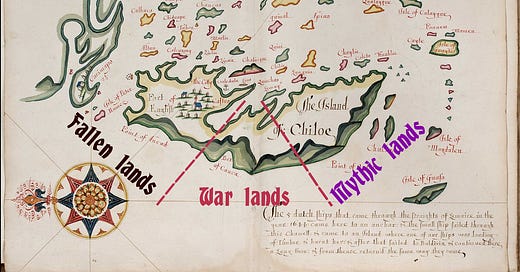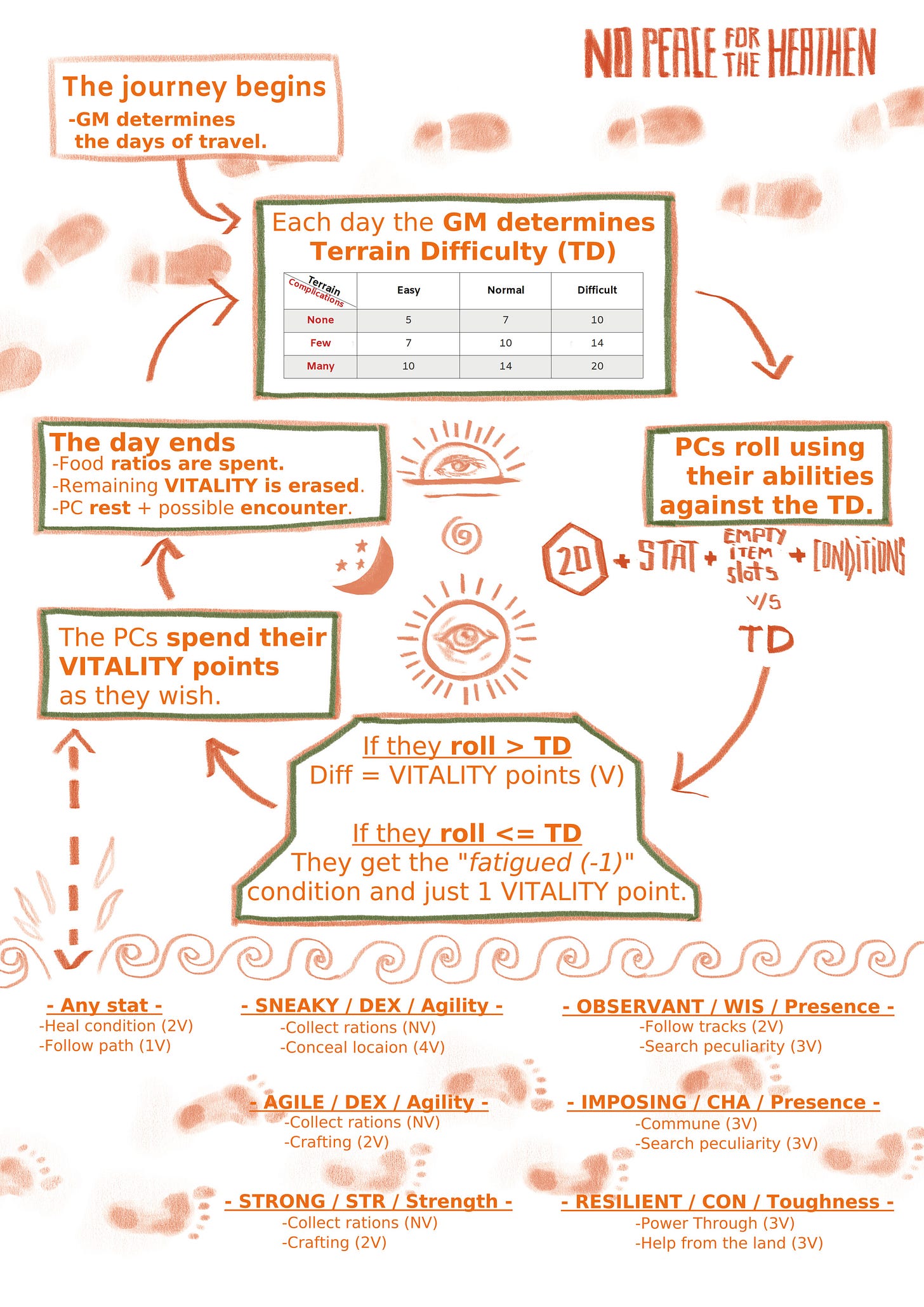As I told you in previous posts, I have been trying to create an exploration procedure that works for my OSR/NSR-like game, No Peace for the Heathen (NPFTH).
Initially, for this exploration procedure, I was to follow the same path that I used for combat and manipulation, i.e; to use these parts of the game to express the strategies of domination over others that islanders have learned from Conquistadors and that they use themselves for their own goals, and probably against Conquistadors.
This was inspired by the idea that D&D-adjacent games (like OSR and NSR games are) are commonly thought to have three pillars: Combat, Social interaction, and exploration, and also, because on these games many times the things that one does are either very close to, or are direct expressions of, a colonizing agenda (kill the other, secure the borders, extrat profit from the unrulling/uncharted lands, etc…).
However, I realized that exploration was becoming difficult to handle through this lens, as it began to morph towards land domination as controlled by “factions” and to larger-scale conflicts for these territories (which could be better managed at par with the skirmish rules for combat). So I decided to leave exploration out of the “domination lens” that I used in combat and manipulation.
Additionally, instead of using a super refined game of resource management to depict travel/exploration, I made it very simple, something that could be solved by one roll per player per day of travel, and that leaves enough breathing space for role-playing to happen and players to interact with each other.
This travel procedure refers to two kinds of tables: encounter tables and peculiarity tables (locations table), so, in principle, you could use any encounter and locations table and any OSR/NSR game with it.
For NPFTH, in the next couple of posts, I’m planning to make three different pairs of these tables, each pair for one of the regions of Isla Grande: Fallen Lands, War Lands, and Mythic Lands.
So here it is, a very simplistic travel procedure.
Travel procedure
At the beginning of a travel, the GM determines how many days of travel it will take the players to get to their destination (assuming they don’t get lost).
This information may be concealed if players haven’t gone to the place before, or if they have no information about the distance in days to the place they wish to reach.
The PCs should narrate what they do each day, in the way they feel more comfortable, and if there is emergent role-play that arises from their narration, they should be free to embrace it. This is just a skeleton to give form to the experience of travel in the game.
At the start of a day
Every player rolls:
(d20 + tactics (attribute/ability) + empty item slots + conditions ) V/S terrain difficulty (TD)
When traveling, players choose which tactic/attribute/ability they use for their daily roll. This will determine what they can do that day while traveling (see below in Using VITALITY points).
Conditions can hinder or help their roll, with a negative or positive modifier, respectively (if you use a game without conditions, you still can use the ones contained in this procedure: fatigue, hunger, and ignore them when the travel/exploration ends).
If you use a system without item slots, you can replace the empty item slots modifier with: -2 if a PC is carrying extra heavy things like a full plate armor, a lot of treasure, or multiple large weapons / +2 if they have just their rations, no armor, and just a couple of weapons / +0 otherwise.
The TD is a number that encompasses all the things that could affect the difficulty of the travel. Instead of defining a “precise/direct” dependencies in biome, season, etc…, depends on the GM ruling about the difficult of the terrain (Easy, Normal, Difficult) and the number of complications that may make the travel of the PCs more difficult (such as if the want to make the travel fast, or if there are extreme weather conditions, or they are being follow, etc…).
The TD is evaluated on a day-by-day basis of travel by the GM, using the table below, and the correspondence between the rows and columns to the in-game specificities of the travel that is presented as a guide below the table.
For Terrain
Easy: Flat, Premade path, Grassland, thin/young forest, etc…
Normal: Forest, Foothills, Valley, etc…
Difficult: Mountains, Tundra, Desert, Swamps, Caverns, etc..
For complications: extreme weather, season, pace, PCs are escaping, PCs are tracking, etc… Few complications could be up to three (<=3), and many complications four and up (4+).
The difference between the dice rolls of each PC and the TD:
If positive, it is the number of VITALITY points they have to spend that day.
If negative, the NPC/PC gets the “fatigued -1” condition (consecutive fatigue conditions add their modifiers to the first one). However, they still get 1 VITALITY point.
Using VITALITY points
VITALITY points can be expended daily to accomplish different tasks.
VITALITY points, if not used, are erased at the end of the day.
The tasks that each PC can accomplish depend on what Tactic/Ability/Ability (NPFTH/OSE/Mork Borg) they used in their roll:
— ANY —
2 VITALITY — Heal condition. Once per day, decrease by 1 the modifier of a condition on yourself or another PC/NPC. Narrate what you do to help heal/overcome that condition.
1 VITALITY — Follow the path. Once per day, decrease by 1 the remaining days of travel.
— SNEAKY / DEX / Agility —
N VITALITY — Collect rations, as many as VITALITY points you use. Up to a maximum of your modifier of SNEAKY/DEX/Agility.
4 VITALITY — Conceal location. No encounter roll.
— AGILE / DEX / Agility —
N VITALITY — Collect rations, as many as VITALITY points you use. Up to a maximum of your modifier of AGILE/DEX/Agility.
2 VITALITY — Crafting. Once per day, advance by 1 a project. Easy/medium/hard/invention projects need 1/3/10/30 advancement to be completed.
— STRONGE / STR / Strength —
N VITALITY — Collect rations, as many as VITALITY points you use. Up to a maximum of your modifier of STRONG/STR/Strength.
2 VITALITY — Crafting. Once per day, advance by 1 a project. Easy/medium/hard/invention projects need 1/3/10/30 advancement to be completed.
— OBSERVANT / WIS / Presence —
2 VITALITY — Follow tracks.
3 VITALITY — Search for peculiarity (roll in peculiarity/location table).
— IMPOSING / CHA / Presence —
3 VITALITY — Commune with spirits of the land. You commune with +1.
3 VITALITY — Search for peculiarity (roll in peculiarity/location table).
— RESILIENT / CON / Toughness —
3 VITALITY — Power through. Once per day, decrease by 1 the modifier of a fatigued and hungry condition.
3 VITALITY — Help from the land. Once per day, you can sense the spirits of the land in the land itself and connect with them. They lend you their support. Decrease by 2 the modifier of any condition.
At the end of the day
For each PC/NPC, one ration of food must be erased from the equipment of any PC/NPC.
If a PC/NPC does not receive a food ration, this PC/NPC does not eat and gets the “hungry (-1)” condition (consecutive hungry conditions add their modifiers to the first one).
Erase any unused VITALITY point.
Rest following the resting rules of the game you are using (resting in NPFTH). If they don’t conceal their location when sleeping, an encounter may happen (roll for an encounter).
Start a new day, go to the beginning, and follow the steps!
CONVERSION FOR OTHER OSR GAMES
…for something like OSE you can use this:
Blood → HP (this is for mortal creatures)
Strong → STR
Agile → DEX
Imposing → CHA
Resilient → CON
Sneaky → DEX
Observant → WIS
…for something like MÖRK BORG you can use this:
Blood → HP (this is for mortal creatures)
Strong → Strenght
Agile → Agility
Imposing → Presence
Resilient → Toughness
Sneaky → Agility
Observant → Presence
…for both you could also add this:
Let the PCs spend “X” HP to increase their roll by “X”.
Every character can carry as much items as their Strength/STR + 10 or Toughness/CON + 10, whichever is larger (small items, such as jewelry, do not count)
Conditions modify the rolls of anything that make sense as their modifier says (spring ankle will hinder jumping, confused will hinder perceptions, anger will hinder interactions, etc…). Conditions stack. Characters can have at most Toughness/CON + 10 conditions, after that, for every new condition they adquire they have to roll Toughness/CON DC 15: if they fail they loose 1 point on an ability/attribute/stat that make sense.






